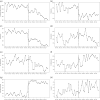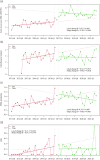Impact of an antimicrobial stewardship programme on antibiotic utilization and resistance burden in patients with acute leukaemia: an 11-year longitudinal cohort study using interrupted time-series analysis
- PMID: 38863389
- PMCID: PMC11290886
- DOI: 10.1093/jac/dkae199
Impact of an antimicrobial stewardship programme on antibiotic utilization and resistance burden in patients with acute leukaemia: an 11-year longitudinal cohort study using interrupted time-series analysis
Abstract
Background: Antimicrobial resistance (AMR), driven by inappropriate and overuse of antibiotics, poses a significant threat, especially to patients with acute leukaemia.
Objectives: To evaluate the impact of antimicrobial stewardship programmes (ASPs) on antibiotic use and analyse temporal changes in bloodstream infections (BSI) caused by AMR organisms.
Methods: We performed a retrospective, interventional, longitudinal cohort study spanning an 11-year period. ASPs included optimizing antibiotic use, enhancing tracking and reporting systems and delineating leadership and accountability. A segmented regression model of interrupted time series was used to evaluate the trend of antibiotic consumption and BSI with AMR organisms after the interventions.
Results: A total of 3296 BSI episodes with 454 419 days of therapy (DOT) from 7754 patients were obtained. ASPs were significantly associated with an immediate reduction [-70.03 DOT/1000 patient-days (PD), P = 0.036] and a decreasing trend (-11.65 DOT/1000 PD per quarter, P < 0.001) in overall antibiotic use. The increasing incidence of BSI with AMR before ASP intervention was notably curbed and revealed a decreasing trend (slope change: -0.06 BSI/1000 PD per quarter, P = 0.002). The decreasing trend was more significant for Enterobacterales: ciprofloxacin-resistant and ESBL-producing isolates showed a slope change of -0.06 BSI/1000 PD and -0.08 BSI/1000 PD per quarter, respectively (all P < 0.05). However, Pseudomonas aeruginosa BSI increased.
Conclusions: Multidimensional ASPs effectively reduced both the immediate and trends in overall antibiotic usage even in patients with acute leukaemia. Additionally, there was a notable decrease in the incidence of BSI caused by AMR organisms, particularly among Enterobacterales.
© The Author(s) 2024. Published by Oxford University Press on behalf of British Society for Antimicrobial Chemotherapy.
Figures




Similar articles
-
The effect of an antimicrobial stewardship programme in two intensive care units of a teaching hospital: an interrupted time series analysis.Clin Microbiol Infect. 2020 Jun;26(6):782.e1-782.e6. doi: 10.1016/j.cmi.2019.10.021. Epub 2019 Oct 31. Clin Microbiol Infect. 2020. PMID: 31678230
-
Long-Term Impact of an Educational Antimicrobial Stewardship Program on Hospital-Acquired Candidemia and Multidrug-Resistant Bloodstream Infections: A Quasi-Experimental Study of Interrupted Time-Series Analysis.Clin Infect Dis. 2017 Nov 29;65(12):1992-1999. doi: 10.1093/cid/cix692. Clin Infect Dis. 2017. PMID: 29020166
-
Impact of a Comprehensive Antimicrobial Stewardship Program on Institutional Burden of Antimicrobial Resistance: A 14-Year Controlled Interrupted Time-series Study.Clin Infect Dis. 2020 Dec 31;71(11):2897-2904. doi: 10.1093/cid/ciz1183. Clin Infect Dis. 2020. PMID: 31813967
-
Antimicrobial consumption and impact of antimicrobial stewardship programmes in long-term care facilities.Clin Microbiol Infect. 2019 May;25(5):562-569. doi: 10.1016/j.cmi.2018.07.028. Epub 2018 Aug 2. Clin Microbiol Infect. 2019. PMID: 30076978
-
Impact of antibiotic stewardship programmes in Asia: a systematic review and meta-analysis.J Antimicrob Chemother. 2018 Apr 1;73(4):844-851. doi: 10.1093/jac/dkx492. J Antimicrob Chemother. 2018. PMID: 29340609 Free PMC article.
Cited by
-
Reducing inappropriate antibiotic use in febrile neutropenia in hematology patients through the implementation of an antibiotic de-escalation protocol.Infect Control Hosp Epidemiol. 2025 May 16;46(7):1-6. doi: 10.1017/ice.2025.90. Online ahead of print. Infect Control Hosp Epidemiol. 2025. PMID: 40375804 Free PMC article.
References
-
- Baur D, Gladstone BP, Burkert Fet al. . Effect of antibiotic stewardship on the incidence of infection and colonisation with antibiotic-resistant bacteria and Clostridium difficile infection: a systematic review and meta-analysis. Lancet Infect Dis 2017; 17: 990–1001. 10.1016/S1473-3099(17)30325-0 - DOI - PubMed
Publication types
MeSH terms
Substances
LinkOut - more resources
Full Text Sources
Medical

